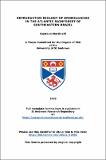Files in this item
Reproductive biology of Bromeliaceae in the Atlantic rainforest of southeastern Brazil
Item metadata
| dc.contributor.advisor | Gibbs, P. E. | |
| dc.contributor.author | Martinelli, Gustavo | |
| dc.coverage.spatial | 310p, 24p of plates | en_US |
| dc.date.accessioned | 2017-06-14T12:29:02Z | |
| dc.date.available | 2017-06-14T12:29:02Z | |
| dc.date.issued | 1995 | |
| dc.identifier | uk.bl.ethos.561600 | |
| dc.identifier.uri | https://hdl.handle.net/10023/10992 | |
| dc.description.abstract | A study was made of the reproductive biology of 35 species of Bromeliaceae in the Atlantic Rainforest province of southeastern Brazil. Three study sites were established, at different altitudinal levels ranging from the sea coast to 1800m, and including a range of forest types and high montane grassland. The studied taxa included 18 species of Vriesea, five of Quesnelia, two of Pitcairnia, two of Nidularium, two of Neoregelia, two of Billbergia two of Aechmea, one of Dyckia and one of Tillandsia. Aspects of flowering phenology, pollination biology, breeding system and fruit-set success were studied for 14 species, whilst less complete data, usually limited for breeding system and fruit-set, was obtained for further 21 species. The flowering phenology of the bromeliad species showed a displacement towards the wet, summer period between November-February, with many species showing overlapping flowering at this time, and thus with little evidence of adaptative phenological displacement. The species could be grouped into two pollination guilds, hummingbirds and bats, with the former predominanting, such that 26 of the 35 species had this vector, whilst seven species, with nocturnal anthesis and scented flowers, were visited by bats. For both kinds of vectors, the flowering strategy known as 'steady state', in which few flowers are opened per day/night over a long period, was the commonest situation encounted, since 'steady state' flowering has been associated with so-called 'traplining' pollinator, in which the vector regularly forages along a sequence of plants. Hand-pollination experiments showed that the majority of species were self-compatible, with fluorescence microscopy studies evincing massive self-pollen germination on the stigma, with growth of pollen tubes to the ovary and high levels of ovule penetration. However, six species were considered to be self-incompatible, and it is of interest that all of these taxa are member of the subfamily Bromelioideae. Despite the prevalence of self-compatibility, it is likely that a 'mixed-mating' system, with some out crossing occurs in many species because of the 'steady state' type of flowering, and also the marked protandry of the flowers at anthesis. | en_US |
| dc.language.iso | en | en_US |
| dc.publisher | University of St Andrews | |
| dc.subject.lcc | QK495.B76M2 | |
| dc.subject.lcsh | Bromeliaceae--Brazil | en |
| dc.title | Reproductive biology of Bromeliaceae in the Atlantic rainforest of southeastern Brazil | en_US |
| dc.type | Thesis | en_US |
| dc.contributor.sponsor | Margaret Mee Amazon Trust | en_US |
| dc.contributor.sponsor | World Wildlife Fund, Brazil (WWF) | en_US |
| dc.contributor.sponsor | Brazilian Research Council CNPq | en_US |
| dc.type.qualificationlevel | Doctoral | en_US |
| dc.type.qualificationname | PhD Doctor of Philosophy | en_US |
| dc.publisher.institution | The University of St Andrews | en_US |
This item appears in the following Collection(s)
Items in the St Andrews Research Repository are protected by copyright, with all rights reserved, unless otherwise indicated.

